

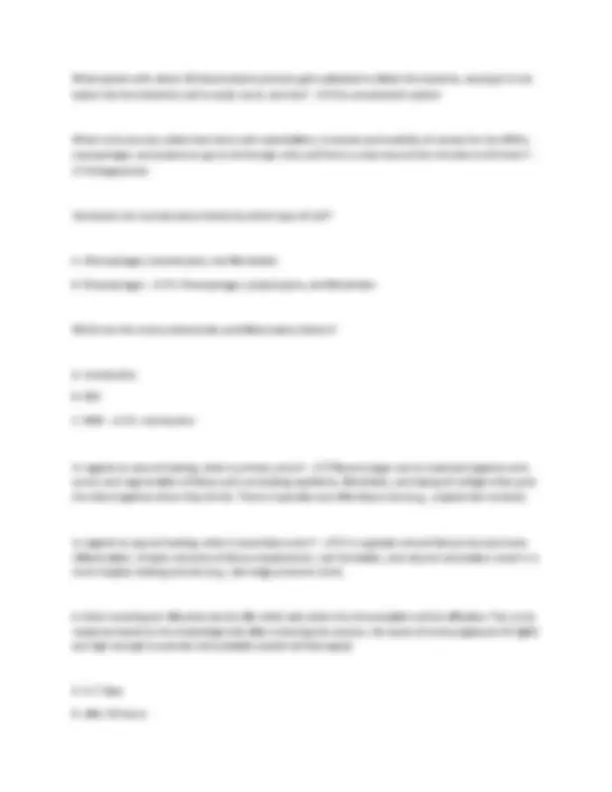
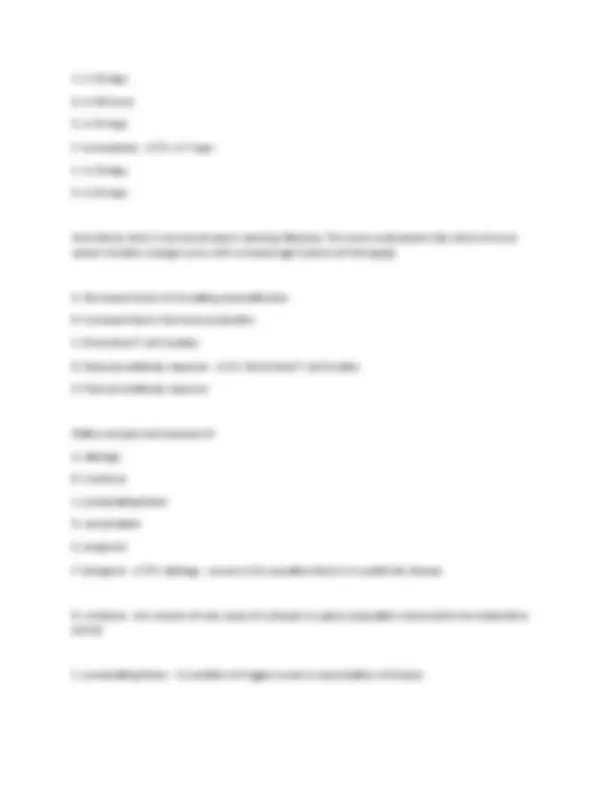
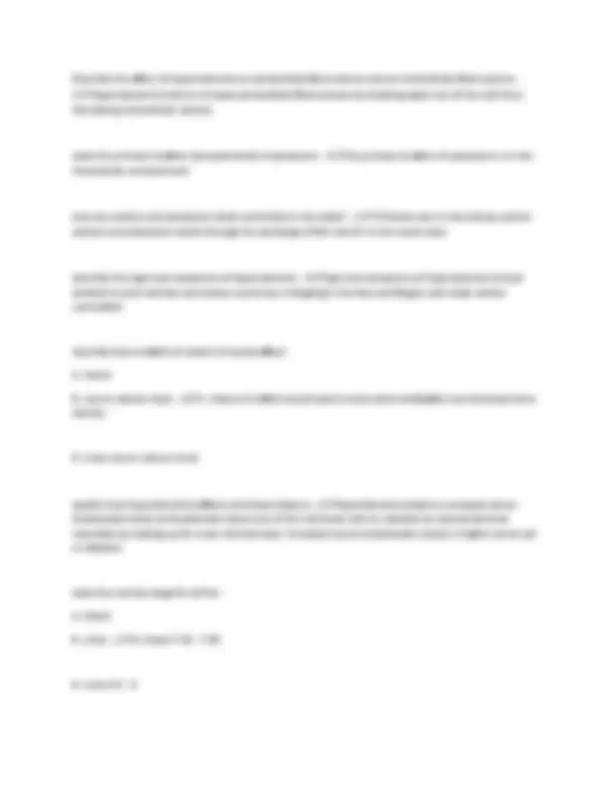
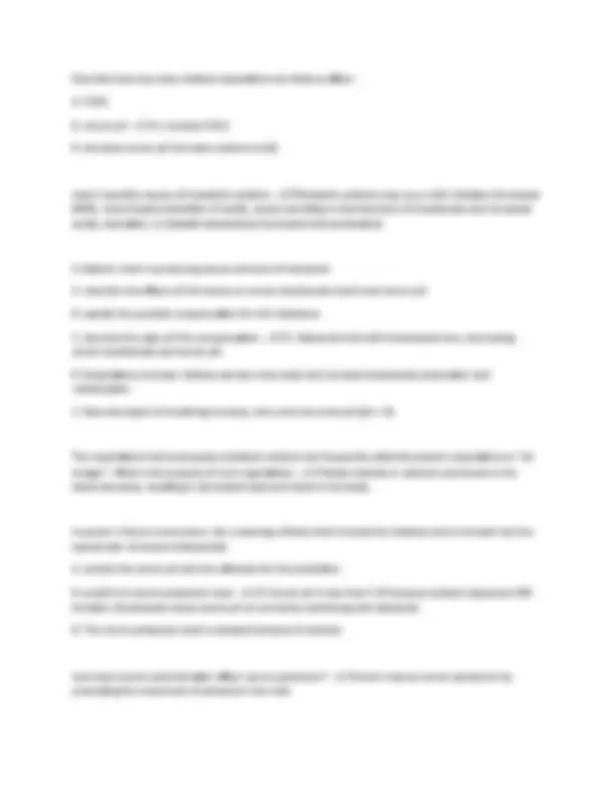
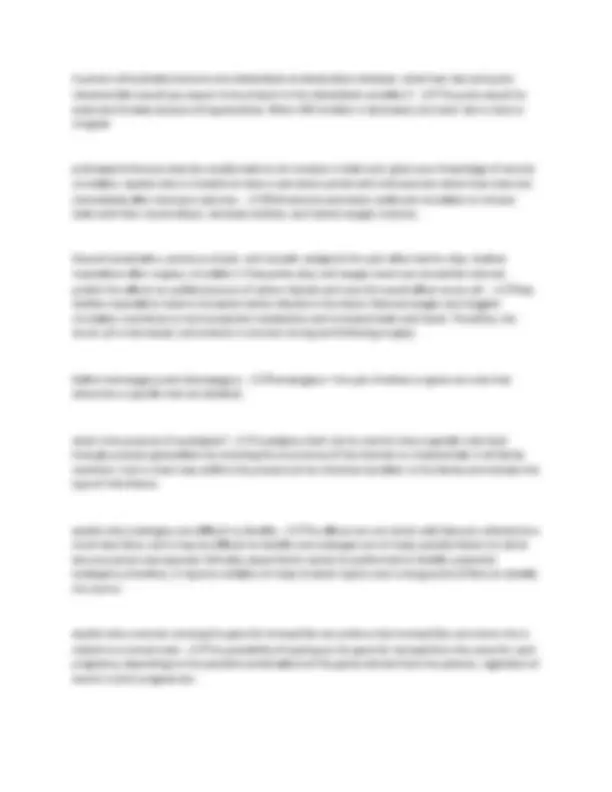


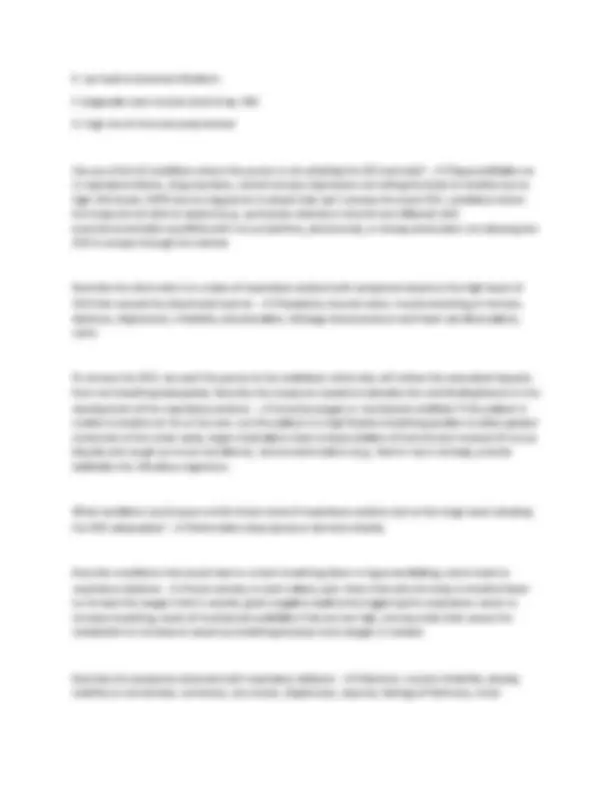
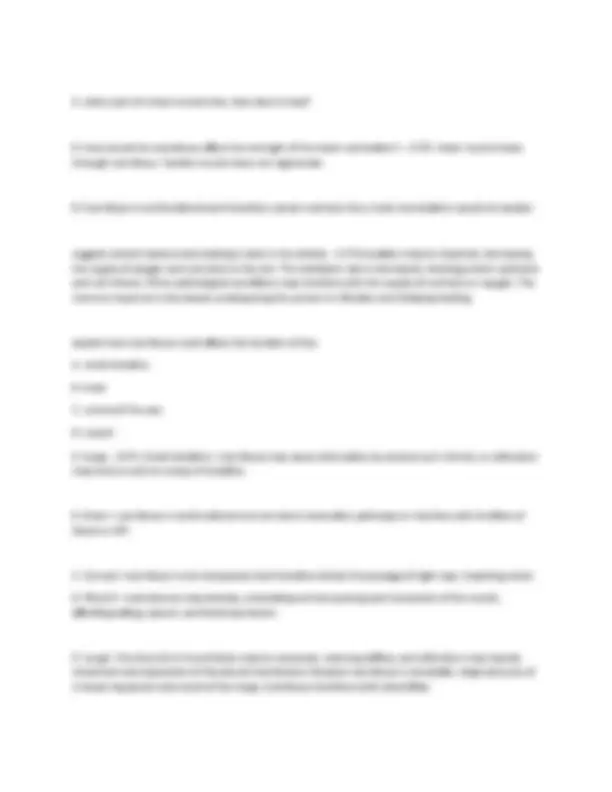



Study with the several resources on Docsity

Earn points by helping other students or get them with a premium plan


Prepare for your exams
Study with the several resources on Docsity

Earn points to download
Earn points by helping other students or get them with a premium plan
Community
Ask the community for help and clear up your study doubts
Discover the best universities in your country according to Docsity users
Free resources
Download our free guides on studying techniques, anxiety management strategies, and thesis advice from Docsity tutors
In regards to chromosomal mutation, nondisjunction is known as what? - ✔✔Failure of homologous chromosomes to separate during cell division What is an example of an autosomal-dominant disease? - ✔✔Huntington's disease What is an example of an autosomal-recessive disease? - ✔✔Cystic fibrosis What is an example of an X-linked condition? - ✔✔Red - green color blindness What is an example of multifactorial inheritance? - ✔✔Pyloric stenosis Knowing physiologic signs of injury you might expect the following system is consistent with systemic manifestations of cellular injury during a myocardial infarction (select all that apply) A. Elevated aspartate aminotransferase (AST/SGOT) C. Increased leukocytes D. Pain E. Increase heart rate F. Fever G. Elevated Creatinine Kinase H. Elevated alanin aminostransferase (ALT/SGPT) - ✔✔A. elevated aspartate aminotransferase C. increased leukocytesE. increased HR G. elevated creatinine kinase
Typology: Exams
1 / 19

This page cannot be seen from the preview
Don't miss anything!












In regards to chromosomal mutation, nondisjunction is known as what? - ✔✔Failure of homologous chromosomes to separate during cell division What is an example of an autosomal-dominant disease? - ✔✔Huntington's disease What is an example of an autosomal-recessive disease? - ✔✔Cystic fibrosis What is an example of an X-linked condition? - ✔✔Red - green color blindness What is an example of multifactorial inheritance? - ✔✔Pyloric stenosis Knowing physiologic signs of injury you might expect the following system is consistent with systemic manifestations of cellular injury during a myocardial infarction (select all that apply) A. Elevated aspartate aminotransferase (AST/SGOT) C. Increased leukocytes D. Pain E. Increase heart rate F. Fever G. Elevated Creatinine Kinase H. Elevated alanin aminostransferase (ALT/SGPT) - ✔✔A. elevated aspartate aminotransferase C. increased leukocytes
E. increased HR G. elevated creatinine kinase H. elevated alanin aminostransferase The nurse teaching an elderly client about the aging process includes which changes that occur as part of the normal aging process? (select all that apply) A. Increase in total body potassium concentration B. Increased gastric emptying C. Decreased muscle tone D. Wrinkling and atrophy of the epidermis E. Increase in peripheral resistance to blood flow F. Increased formation of autoantibodies - ✔✔A. Decreased muscle tone, wrinkling in atrophy of the epidermis E. increase in peripheral resistance to bloodflow F. increased formation of auto antibodies What else is it about the skin that protects individuals from injury and disease? - ✔✔Pathogens can be sloughed off by mechanical means, such as falling off in dead skin cells, coughing or sneezing, vomiting, or flushing from the urinary tract in urine. How might the characteristics of skin and the bodily fluids associated with it also help to protect us from infection? - ✔✔There is a low pH on the skin and stomach that generally inhibits microorganisms If inflammation is considered a first responder and may be considered to be a hero, at least when it is in a controlled state, what heroic acts may be attributed to it? How might the swelling associated with inflammation actually help with the healing process? Erythema and warmth at a site of injury typically cause discomfort, but how might one take solace in the fact that the response is being initiated? - ✔✔It prevents and/or limits infection and additional damage by initiating the influx of plasma, plasma proteins, plasma enzymes, and the distribution of leukocytes from the blood vessels to the injury. It recruits members of the adaptive immunity community to launch a more specific defense against the pathogens and enhances the healing process.
What system with about 20 blood plasma proteins gets activated to attack the bacteria, causing it to let water into the bacteria's cell to swell, burst, and die? - ✔✔the complement system What is the process called that starts with vasodilation; increases permeability of vessels for the WBCs, macrophages, and plasma to go to the foreign cells; and forms a coat around the microbe to kill them? - ✔✔phagocytosis Interleukin six is produced primarily by which type of cell? A. Macrophages, lymphocytes, and fibroblasts B. Macrophages - ✔✔A. Macrophages, lymphocytes, and fibroblasts Which are the most predominate proinflammatory factors? A. interleukins B. RBC C. WBS - ✔✔A. interleukins In regards to wound healing, what is primary union? - ✔✔Wound edges can be matched together with serum and regeneration of tissue and connecting capillaries, fibroblasts, and laying of collagen that pulls the sides together when they shrink. There is typically very little tissue loss (e.g., surgical skin incision). In regards to wound healing, what is secondary union? - ✔✔It is a greater area of tissue loss and more inflammation. Greater amounts of tissue replacement, scar formation, and wound contraction result in a more lengthy healing process (e.g., late stage pressure ulcer). A client receiving an influenza vaccine (flu shot) asks when the immunization will be effective. The nurse response based on the knowledge that after receiving the vaccine, the levels of immunoglobulin M (IgM) are high enough to provide immunization (select all that apply) A. in 7 days B. after 24 hours
C. in 10 days D. in 48 hours E. in 14 days F. immediately - ✔✔A. in 7 days C. in 10 days E. in 14 days And elderly client is concerned about catching influenza. The nurse understands that which immune system function changes occur with increased age? (select all that apply) A. Decreased levels of circulating autoantibodies B. Increased thymic hormone production C. Diminished T cell function D. Reduced antibody response - ✔✔C. Diminished T cell function D. Reduced antibody response Define and give and example of: A. etiology B. incidence C. precipitating factor D. complication E. prognosis F. iatrogenic - ✔✔A. etiology - concerns the causative factors in a particular disease B. incidence - the number of new cases of a disease in a given population noted within the stated time period. C. precipitating factor - A condition of triggers onset or exacerbation of disease
examination of living tissue. (some terms may not be used or may be used more than once) - ✔✔malignant breast tumor and high blood pressure = diagnosis high blood pressure and family cancer = medical history medication = treatment surgery = treatment and diagnosis biopsy = examination of living tissue Describe the locations of intracellular and extracellular fluids - ✔✔INTRACELLULAR FLUID: fluid contained within the cells EXTRACELLULAR: includes all fluids outside the cells, such as blood, interstitial fluid, CSF, digestive tract secretions, plural fluid, and lymph which makes up the higher proportion of body fluid: intracellular fluid or extracellular fluid? - ✔✔intracellular fluid makes up the higher proportion of body fluid how does the proportion of fluid in the body change with age? - ✔✔The proportion of fluid in the body decreases throughout the lifespan Why does dehydration affect cell function? - ✔✔dehydration affects cell function because the transport of nutrients into the cell and removal of wastes from cell are decreased impairing cell metabolism and function Is the function of sodium ion in the body? - ✔✔Sodium ions help me teen extracellular fluid (as the major cation exerting osmotic pressure), contribute to neuromuscular function and play a role an acid- base balance in metabolic processes
Describe the effect of hypernatremia on extracellular fluid volume and on intracellular fluid volume - ✔✔Hypernatremia tends to increase extracellular fluid volume by drawing water out of the cells thus decreasing intracellular volume state the primary location (compartment) of potassium - ✔✔the primary location of potassium is in the intracellular compartment how are sodium and potassium levels controlled in the body? - ✔✔I'll Doster own in the kidney control sodium and potassium levels through the exchange of Na+ and K+ in the renal tubes describe the signs and symptoms of hypocalcemia - ✔✔Signs and symptoms of hypocalcemia include skeletal muscle twitches and tetany numbness in tingling in the face and fingers and weak cardiac contraction describe how a deficit of vitamin D would affect: A. bones B. serum calcium level - ✔✔A. vitamin D deficit would lead to bone demineralization and decrease bone density B. a low serum calcium level explain how hypochloremia affects acid-base balance - ✔✔Hypochloremia leads to increased serum bicarbonate levels as bicarbonate moves out of the red blood cells to maintain an electrochemical neutrality by making up for a low chloride level. Increased serum bicarbonate results in higher serum pH or alkalosis state the normal range for pH for: A. blood B. urine - ✔✔A. blood 7.35 - 7. B. urine 4.5 - 8
A person will probably become very dehydrated as ketoacidosis develops. what hear rate and pulse characteristics would you expect to be present in this dehydrated condition? - ✔✔The pulse would be weak and thready because of hypovolemia. When CNS function is decreased, the heart rate is slow or irregular. prolonged strenuous exercise usually leads to an increase in lactic acid. given your knowledge of normal circulation, explain why it is helpful to have a cool-down period with mild exercise rather than total rest immediately after strenuous exercise. - ✔✔Mild exercise promotes continued circulation to remove lactic acid from muscle tissue, decrease acidosis, and restore oxygen reserves. General anesthetics, presence of pain, and narcotic analgesics for pain often lead to slow, shallow respirations after surgery, circulation is frequently slow, and oxygen levels are somewhat reduced. predict the effects on partial pressure of carbon dioxide and now this would affect serum pH. - ✔✔Slow, shallow respirations lead to increased carbon dioxide in the blood. Reduced oxygen and sluggish circulation contribute to more anaerobic metabolism and increased lactic acid levels. Therefore, the serum pH is decreased, and acidosis is common during and following surgery. Define homozygous and heterozygous - ✔✔Homozygous—the pair of alleles or genes at a site that determine a specific trait are identical. what is the purpose of a pedigree? - ✔✔A pedigree chart can be used to trace a genetic trait back through previous generations by checking the occurrence of the disorder or characteristic in all family members. Such a chart may confirm the presence of an inherited condition in the family and indicate the type of inheritance. explain why teratogens are difficult to identify - ✔✔The effects are not noted until data are collected at a much later time, and it may be difficult to identify one teratogen out of many possible factors to which any one person was exposed. Ethically, experiments cannot be performed to identify suspected teratogens; therefore, it requires collation of many incident reports over a long period of time to identify the source. explain why a woman carrying the gene for hemophilia can produce two hemophiliac sons when she is mated to a normal male - ✔✔The probability of passing on the gene for hemophilia is the same for each pregnancy, depending on the possible combinations of the genes derived from the parents, regardless of events in prior pregnancies.
under what conditions does a female acquire an X-linked recessive disorders - ✔✔Both parents must carry the defective gene for the female child to be affected. A female child may be a carrier if either parent passes on the defective gene. why are X-linked recessive disorders never passed from a father to son - ✔✔The father passes his Y chromosome to a son, not the X chromosome carrying the defective gene. the pedigree for Queen Victoria of England, a carrier of hemophilia A, shows the transmission to some of her descendants, including members of many royal families in Europe, such as Russia and Spain but not Germany. Hemophilia A does not affect anyone in the present British royal family. Can you explain why hemophilia A has disappeared from one family and appeared in others? - ✔✔If an unaffected female child mates with an unaffected male, hemophilia A will not be carried forward. A female carrier child who mates with an unaffected male from a different family could produce affected children what is the probability that a parent carrying a dominant trait will pass the trait on to each child - ✔✔The probability that a parent carrying a dominant trait will pass that trait on is a 50% chance with each pregnancy how can prenatal diagnosis demonstrate the sex of an unborn child - ✔✔Chromosome analysis indicates the components of pair 23, XX or XY. Ultrasound may show the penis. describe briefly amniocentesis and its purpose - ✔✔A needle is inserted through the abdominal wall into the uterus and amniotic sac, guided by ultrasound visualization and a small amount of amniotic fluid is withdrawn. The fluid is tested for marker enzymes or chemicals that are significant in certain diseases and the fetal cells in the fluid are cultivated for several weeks. As the cells proliferate, chromosomes may be extracted from a cell, a karyotype prepared to check for chromosome abnormalities in the fetus, and DNA testing may be done. which of the following can be identified by an abnormal karaotype? A. sickle cell disease B. Cystic Fibrosis C. Monosomy X D. Tay-Sachs disease
B. caused by a blood clot in the deep veins C. a roadblock to gas exchange D. damaging to the lung E. caused by injury, surgery or inherited disorders - ✔✔B. caused by a blood clot in the deep veins C. a roadblock to gas exchange D. damaging to the lung E. caused by injury, surgery or inherited disorders symptoms of TB include A. increase in energy B. weight gain C. weight loss D. bloody sputum E. daytime fever F. night sweats - ✔✔C. weight loss D. bloody sputum F. night sweats Which are risk factors for TB (select all that apply) A. inadequate nutritional support B. diminished immune system C. crowded living conditions D. homelessness E. adequate nutritional support - ✔✔A. inadequate nutritional support B. diminished immune system C. crowded living conditions D. homelessness
TB disease progression can be stopped by which? (select all that apply) A. Appropriate antibiotics B. TB skin test C. Appropriate antivirals D. A healthy immune system - ✔✔A. appropriate antibiotics D. a healthy immune system Tuberculosis is A. caused by mycobacterium B. diagnosed by a chest X-ray and sputum culture C. caused by human immunodeficiency virus D. highly contagious E. difficult to catch - ✔✔A. caused by mycobacterium B. diagnosed by a chest X-ray and sputum culture D. highly contagious viral pneumonia has the following characteristics (select all that apply) A. diagnostic tests include spiral CT , BMP B. S/S include cough, fever chills and malaise C. more virulent than bacterial pneumonia D. less virulent than bacterial pneumonia E. can lead to bacterial infections F. diagnostic tests include chest X-ray, CBC G. high risk if immunocompromised - ✔✔B. S/S include cough, fever, chills and malaise D. less virulent than bacteria pneumonia
What symptoms are the same for both alkalosis and acidosis? - ✔✔dizziness, muscle twitching and irritability, disorientation and confusion, diaphoresis, coma What would the respiratory rate range be like if you are experiencing respiratory alkalosis? - ✔✔it can be as high as 40/minute, like panting A. explain why a cast placed around a fractured leg in which extensive tissue damage has occured might be too tight after after 24 hrs? B. explain why such a cast might become loose in 3 weeks - ✔✔A. Inflammation related to tissue damage causes increasing edema for at least 48 hours under the rigid, non-expandable cast. B. Inflammation has subsided and muscle atrophy has occurred because of immobility. list specific reasons why the inflammatory response is considered a body defense mechanism - ✔✔Pain and visible redness provide warning of tissue injury. Increased fluid at the site dilutes any toxic material. Fibrin mesh and leukocytes localize (wall off) the causative agent. Migration of phagocytic cells, leukocytes, and antibodies (globulins) to the area combat or destroy the agent, and remove debris in preparation for healing. A. explain the rationale for each of the following with acute inflammation: (i) warmth, (ii) fever. B. state three systemic signs of inflammation - ✔✔A. Warmth results from vasodilation and increased blood flow to the area; fever is caused by the release of pyrogens from WBCs. B. Low-grade fever occurs with increased WBCs, malaise, anorexia, and headache. explain why leukocytosis, a differential count, and elevated ESR are useful data but are of limited value - ✔✔They confirm the presence of inflammation in the body but do not define the specific cause or location of the problem. In some cases, a differential count is helpful.
A. explain how acute inflammation predisposes to development of infection B. classify each as inflammation or infection: (i) sunburn, (ii) skin rash under adhesive tape, (iii) common cold, (iv) red, swollen eye with purulent exudate - ✔✔a. The increased permeability may permit leakage or penetration of toxins or bacteria (e.g., through the intestinal wall). Any necrosis breaks the barrier, allowing microbes to invade. The edema or increased interstitial fluid may impair arterial flow to an area, leading to ischemia and decreased access of leukocytes to the site. The exudate provides a nutritious medium for organisms to reproduce. b. Inflammation accompanies i and ii; infection is associated with iii and iv. how does the presence of thick, cloudy, yellowish fluid in the peritoneal cavity differ from the normal state? - ✔✔Normal fluid should be watery, clear, and colorless. Thick yellowish fluid often indicates the presence of a bacterial infection (peritonitis) if a large volume of fluid has shifted from the blood into the peritoneal cavity, how would this affect blood volume and hematocrit? - ✔✔Blood volume would be low (hypovolemia), and the hematocrit level would be elevated. explain how acute inflammation impairs movement of a joint - ✔✔Excessive fluid in the joint cavity and surrounding tissues prevents further stretching of the tissues, such as ligaments, tendons, and skin, as required for movement. explain two mechanisms used to increase body temperature as a fever develops? - ✔✔The body attempts to increase body temperature through shiver-increased skeletal muscle activity, peripheral vasoconstriction, and decreased blood flow and heat loss. why might a cleint be advised to avoid taking ASA a few days before extensive oral surgery? (multiple tooth extractions) - ✔✔Aspirin (acetylsalicylic acid [ASA]) interferes with blood clotting (prevents platelet adhesion). explain why a young child taking prednisone (glucocorticoid) for chronic kidney inflammation is at high risk for infection and might need prophylactic antibodies? - ✔✔Prednisone decreases the immune response, causes atrophy of lymphoid tissue, decreases the number of leukocytes, and suppresses the inflammatory response, thus decreasing resistance to infection.
A. explain the rationale for pain and redness accompanying a burn B. explain three reasons why protein levels in the body are low after a major burn - ✔✔A. Pain— chemical mediators irritate nerves; edema results from increased capillary permeability; erythema occurs because of increased blood in the area. B. Over the long term, lower protein levels occur, with protein shifts into tissue and loss in exudates. In addition, protein is in increased demand for repair, but anorexia results in decreased intake, further lowering protein levels.